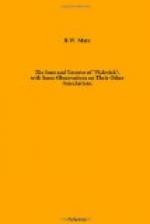“Great, rambling, queer old places they are, with galleries and passages and staircases, wide enough and antiquated enough to furnish materials for a hundred ghost stories, supposing we should ever be reduced to the lamentable necessity of inventing any, and that the world should exist long enough to exhaust the innumerable veracious legends connected with old London Bridge and its adjacent neighbourhood on the Surrey side.
“It was in the yard of one of these inns—of no less celebrated a one than the ’White Hart’—that a man was busily employed in brushing the dirt off a pair of boots, early on the morning succeeding the events narrated in the last chapter. He was habited in a coarse-striped waistcoat, with black calico sleeves, and blue glass buttons, drab breeches and leggings. A bright red handkerchief was wound in a very loose and unstudied style round his neck, and an old white hat was carelessly thrown on one side of his head. There were two rows of boots before him, one cleaned and the other dirty, and at every addition he made to the clean row, he paused from his work, and contemplated its results with evident satisfaction.”
This, we need hardly say, was the inimitable Sam Weller, and it was his first introduction to the story with which his name is now inseparable.
[illustration: The White Hart Inn, Southwark, in 1858. From an engraving by Fairholt, after a drawing by J. Sachs]
Dickens then goes on to give further particulars of how the yard looked on the particular morning of which he writes:
“The yard presented none of that bustle and activity which are the usual characteristics of a large coach inn. Three or four lumbering wagons, each with a pile of goods beneath its ample canopy, about the height of the second-floor window of an ordinary house, were stowed away beneath a lofty roof which extended over one end of the yard; and another, which was probably to commence its journey that morning, was drawn out into the open space. A double tier of bedroom galleries, with old, clumsy balustrades, ran round two sides of the straggling area, and a double row of bells to correspond, sheltered from the weather by a little sloping roof, hung over the door. . . . Two or three gigs and chaise-carts were wheeled up under different little sheds and penthouses; and the occasional heavy tread of a carthorse or rattling of a chain at the further end of the yard announced to anybody who cared about the matter that the stable lay in that direction. When we add that a few boys in smock frocks were lying asleep on heavy packages, wool-packs and other articles that were scattered about on heaps of straw, we have described as fully as need be the general appearance of the yard of the White Hart Inn, High Street, Borough, on the particular morning in question.”




